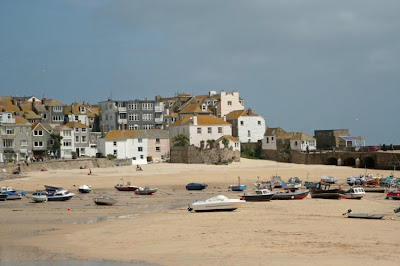Cornwall is magical. With its history of smugglers, mermaids, ghosts and small people, with its moors, coastal walks, fishing villages and secret sandy beaches, plus its beautiful wild flowers and bird life, it has something for everyone:
St Ives Harbour
People have holidayed in Cornwall since the late 19th century and it's interesting to note how holidays have changed over this time. For my mother, it was the land of smugglers, faeries and cream teas. For myself, it was the land of water parks, tin mines and Cornish pasties. For our children, it is surfing, beach bars, the Eden project and cappuccinos:
Derelict Tin Mine and Eden Project
Early visitors to Cornwall would have had little in the way of luxury unless they were one of the "rich" who could afford to travel by "motor car" and stay in hotels. For those pre-war holidays, it was promenades along the sea front "taking the air" and "house parties" in private residences:
Holiday by Car and Newquay Hotel in the 1920's
The inter-war period saw the annual holiday become part of the lives of large numbers of people with rail travel enabling people to go further afield; clearly illustrated by the posters produced by the Great Western Railway (GWR) promoting trips to the Cornish Riviera:
Great Western Railway Poster Advertising Cornish Holidays
By the 40's and 50's, as the war receded, Cornwall became much more popular. People were still travelling mainly by train, but bus, coach and car journeys were becoming more widespread. These were still days of simple enjoyment with a daily timetable of beach visits, home-made picnics, excursions into the local towns and afternoon cream teas:
Poster advertising coach trips to Cornwall in the Summer
As we moved into the 60's and 70's, people wanted more freedom. Cars and self-catering became the norm, whether it be villas, mobile homes, camping, hotels; no one wanted the old style boarding house or bed & breakfast any more:
Then, the era of the motorway arrived making Cornwall more accessible to people with modest means; with a freedom never enjoyed before, holidays no longer had to revolve around a single base; trips could now be taken around the neighbouring countryside and other parts of the coast:
Map of Cornwall
In line with the influx of visitors, we have seen a massive growth in facilities for tourists; shops, restaurants, galleries and museums promoted on a scale never envisaged in Cornwall; old style decor featuring smugglers caves and lobster pots discarded in favour of more sophisticated tastes:
Tate Gallery In St Ives
However, despite changing styles, the real Cornwall remains for you to discover in your own way. Whether you are a regular visitor, or planning a visit for the first time, you cannot fail to be delighted by this wonderful haven of natural beauty.
For places to stay, try the Look What I Have Found website - it's quick and easy to use and there's a chance of finding a real bargain.
And, for useful websites, see the links below:
- Guide to Cornwall
- Cornish Beaches
- Things for Kids
- Nice Places to Eat
- Tate Gallery, St Ives
- Great Cornish Gardens
- Historic Cornwall
- Cornwall Wild Life Trust
- Where to Fish
- Cornish Antiques








1 comment:
Cornwall is indeed magical both in its history and architecture, so does the hotels in Cornwall. :)
Post a Comment